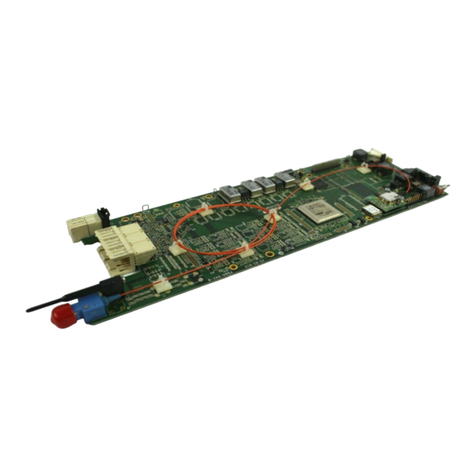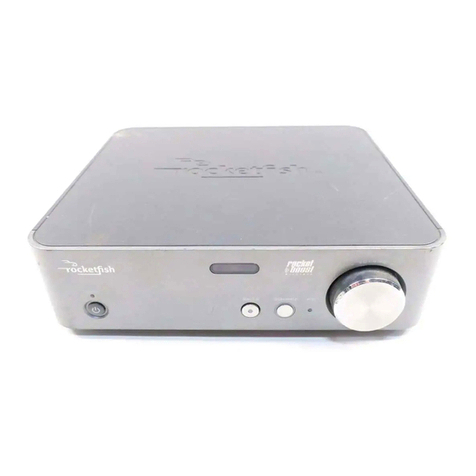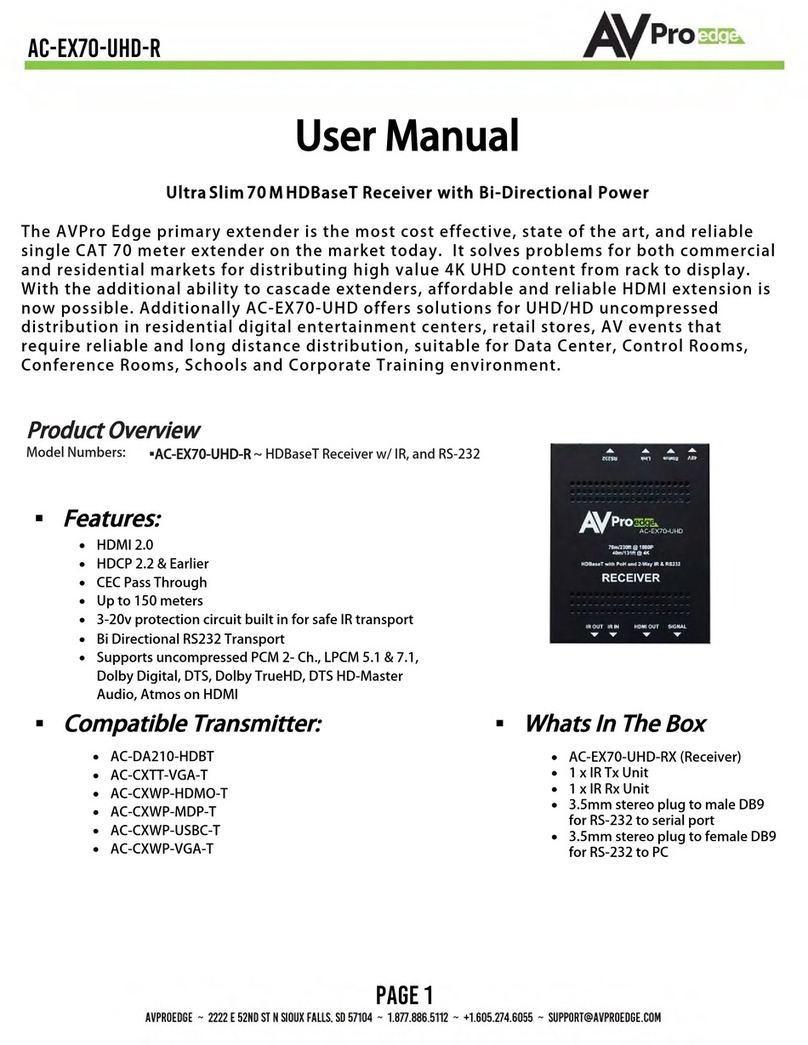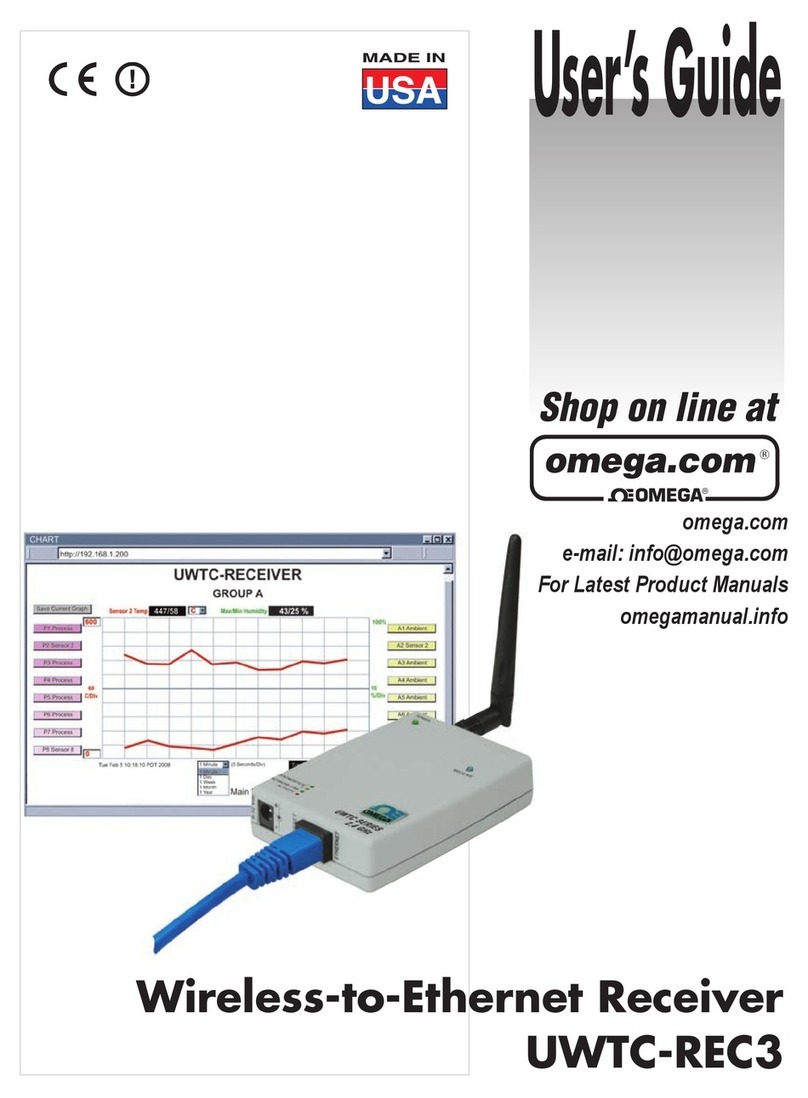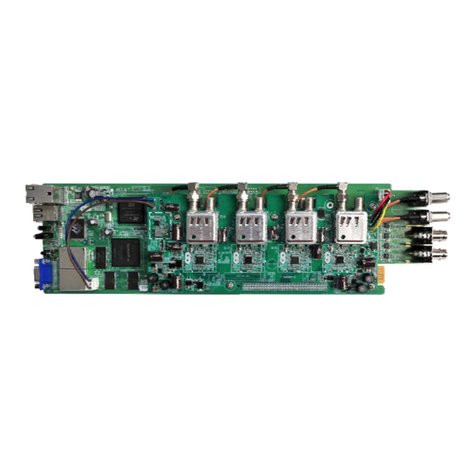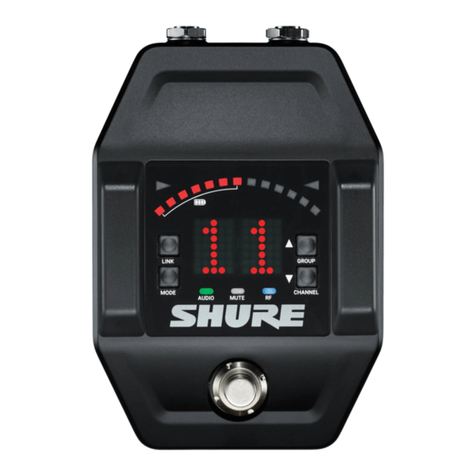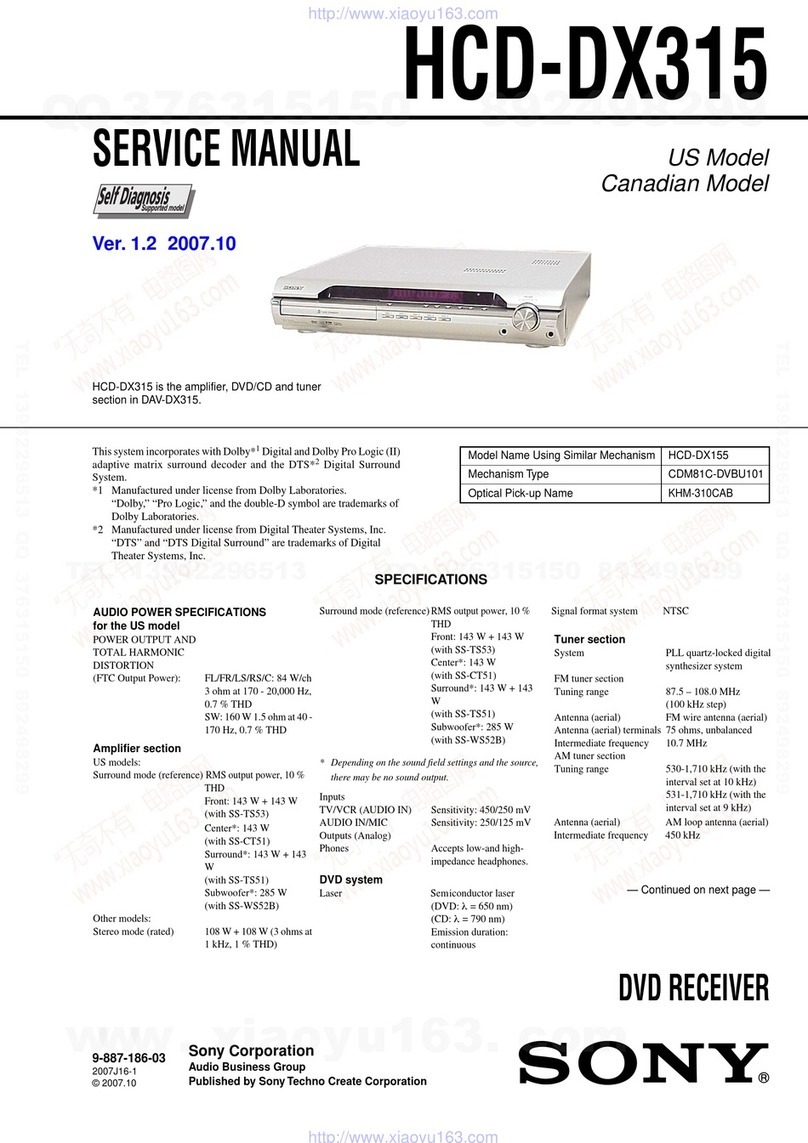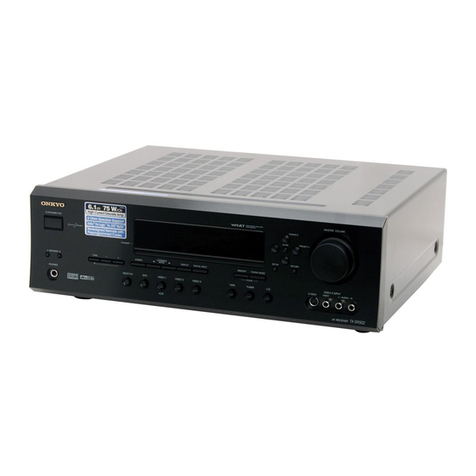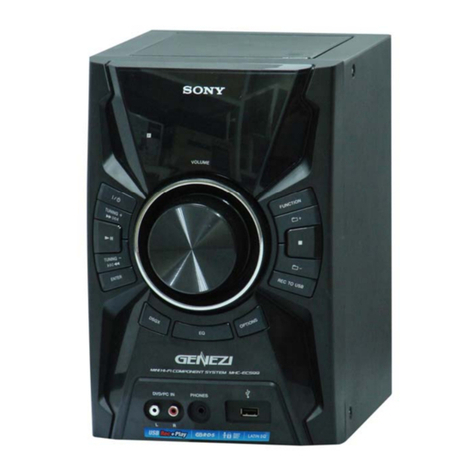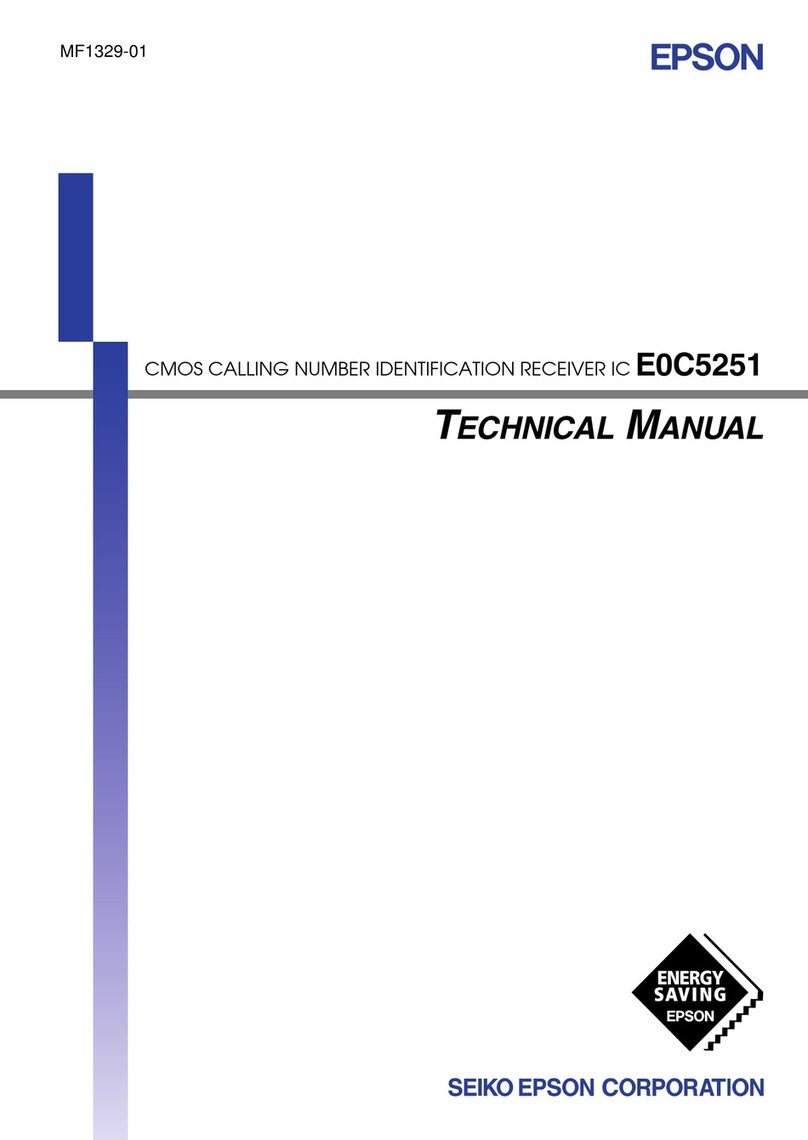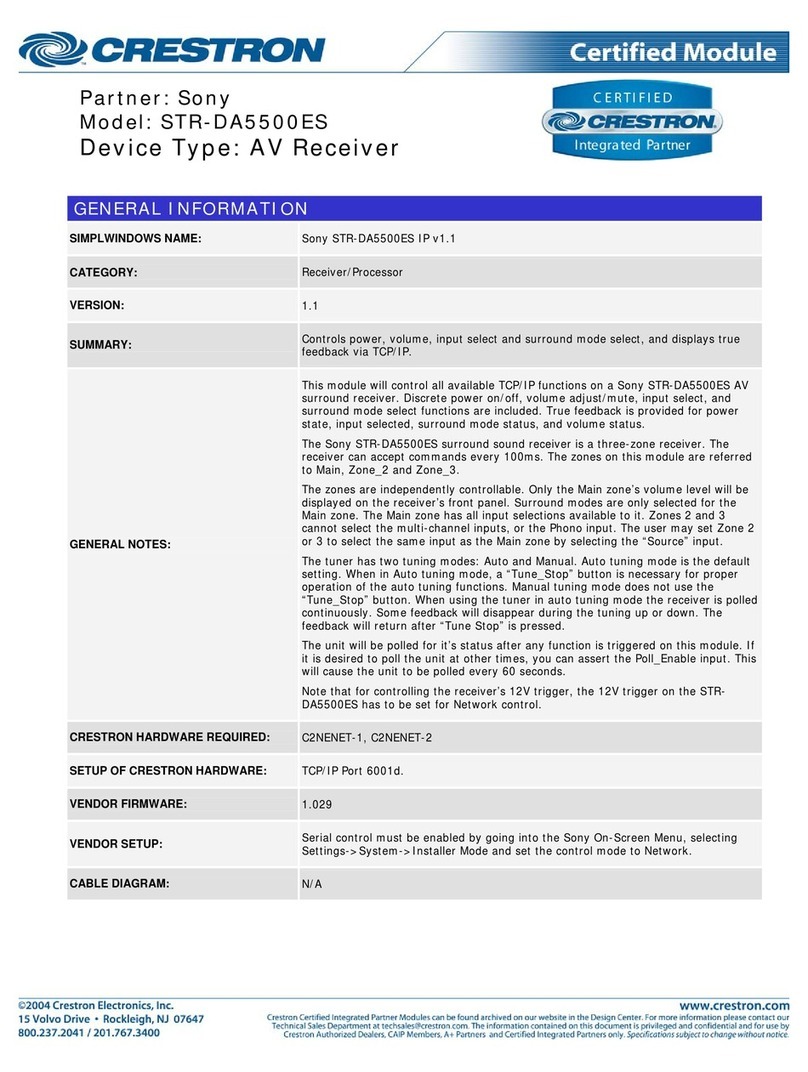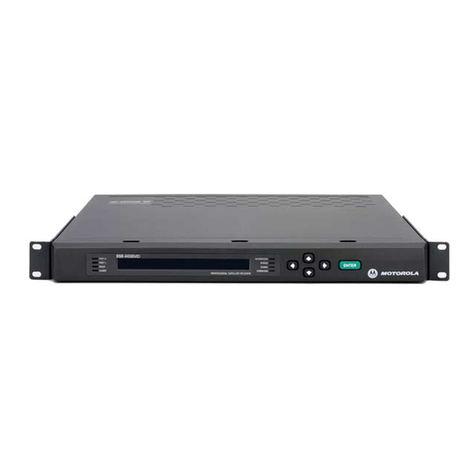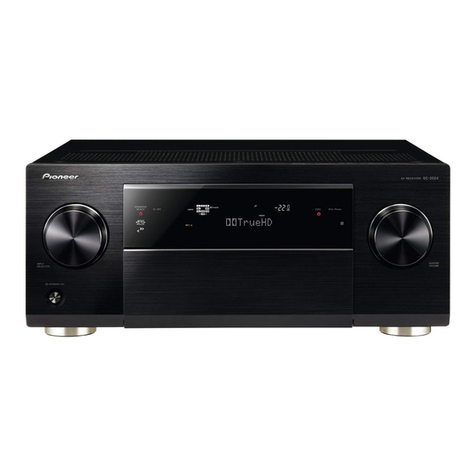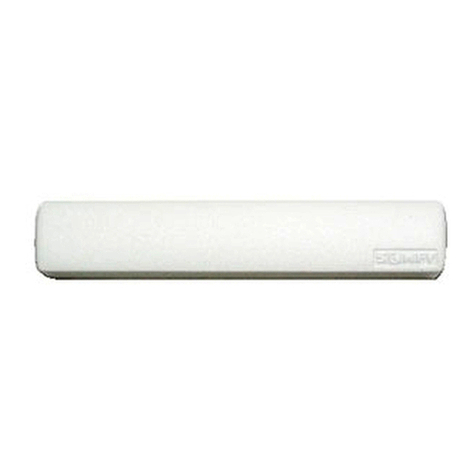Everlz 7707VR-4 User manual

7700 MultiFrame Manual
7707VR-4 Quad SDI Fiber Receiver
Revision 1.3
TABLE OF CONTENTS
1. OVERVIEW.......................................................................................................................................... 1
2. INSTALLATION................................................................................................................................... 2
2.1. CARE AND HANDLING OF OPTICAL FIBER............................................................................ 3
3. SPECIFICATIONS............................................................................................................................... 4
3.1. OPTICAL INPUT......................................................................................................................... 4
3.2. SERIAL VIDEO OUTPUTS......................................................................................................... 4
3.3. ELECTRICAL ............................................................................................................................. 4
3.4. PHYSICAL.................................................................................................................................. 4
4. STATUS INDICATORS AND DISPLAYS ........................................................................................... 5
4.1. STATUS INDICATOR LEDS....................................................................................................... 5
4.2. DOT-MATRIX DISPLAY............................................................................................................. 7
4.2.1. Displaying the Optical Power.......................................................................................... 8
4.2.2. Displaying the Output Video Standard............................................................................ 9
4.2.3. Video Output On Loss.....................................................................................................9
4.2.4. Signal BLOCK Configuration......................................................................................... 10
4.2.5. Setting the Orientation of the Text on the Card Edge Display....................................... 10
4.2.6. Displaying the Firmware Version................................................................................... 11
4.2.7. Upgrade Mode............................................................................................................... 11
5. JUMPERS AND LOCAL CONTROLS .............................................................................................. 12
5.1. SELECTING WHETHER LOCAL FAULTS WILL BE MONITORED
BY THE GLOBAL FRAME STATUS ........................................................................................ 12
5.2. SELECTING WHETHER THE MODULE WILL BE CONTROLLED FROM THE
LOCAL CONTROLS OR THROUGH THE VISTALINK®INTERFACE ...................................... 12
5.3. CONFIGURING THE MODULE FOR FIRMWARE UPGRADES.............................................. 12
6. VISTALINK®REMOTE MONITORING/CONTROL........................................................................... 13
6.1. WHAT IS VISTALINK®?............................................................................................................. 13
6.2. VISTALINK®MONITORED PARAMETERS .............................................................................. 13
6.3. VISTALINK®CONTROLLED PARAMETERS ........................................................................... 14
6.4. VISTALINK®TRAPS.................................................................................................................. 14

7700 MultiFrame Manual
7707VR-4 Quad SDI Fiber Receiver
Revision 1.3
Figures
Figure 1-1: 7707VR-4 Block Diagram...................................................................................................................1
Figure 2-1: 7707VR-4 Rear Panel.........................................................................................................................2
Figure 4-1: Location of Status Indicators and Jumpers ........................................................................................5
Figure 4-2: Display Menu Structure ......................................................................................................................7
Tables
Table 6-1: VistaLINK®Monitored Parameters.....................................................................................................13
Table 6-2: VistaLINK®Controlled Parameters...................................................................................................14
Table 6-3: VistaLINK®Traps..............................................................................................................................14

7700 MultiFrame Manual
7707VR-4 Quad SDI Fiber Receiver
Revision 1.3
REVISION HISTORY
REVISION DESCRIPTION DATE
1.0 Original Version July 03
1.1 Updated safety section and added assembly and labeling section July 05
1.2 Added table format to section 4. General clean up. Feb 09
1.3 Updated video enable/disable LED status. Added support for continuous and Feb 09
discontinuous video modes.

7700 MultiFrame Manual
7707VR-4 Quad SDI Fiber Receiver
Revision 1.3
WARNING
Never look directly into an optical fiber. Non-reversible damage to the eye can
occur in a matter of milliseconds.
"
Do not hook up the 7707VT-4 DWDM cards and 7707VR-4 cards directly with a
short fiber optic cable. The 7707VT-4 DWDM card produces +7dBm of power
which will damage the receiver if connected directly.
"
Do not hook up the 7707VT-4 cards that output more than -7dBm of power
(see 7707VT-4 specifications for output power of various laser types) and
7707VR-4-H high sensitivity receiver cards directly with a short fiber optic
cable. The 7707VT-4 cards that produce more than -7dBm of power will
damage the receiver if connected directly.

7700 MultiFrame Manual
7707VR-4 Quad SDI Fiber Receiver
Revision 1.3 Page-1
1. OVERVIEW
The 7707VR-4 is a VistaLINK®– enabled fiber optic receiver for SDI, DVB-ASI or SDTi signals. This
single card module demultiplexes up to four SDI, DVB-ASI or SDTi video signals that have been Time
Domain Multiplexed (TDM) by the companion 7707VT-4 Quad SDI Fiber Transmitter module.
The 7707VR-4 and companion 7707VT-4 will transparently pass embedded AES audio or any other data
in the horizontal or vertical ancillary data space. Monitoring and control of card status and parameters is
provided locally at the card edge or remotely via VistaLINK®.
Features:
•Single card demultiplexor for four synchronous or asynchronous 270Mb/s SDI, DVB-ASI or SMPTE
305M video signals
•SDI video regeneration on outputs
•Signal transport over fiber uninterrupted by loss of any input video feed
•Transparently passes embedded AES or any other data in the horizontal or vertical ancillary data
space
•Comprehensive signal and card status monitoring via four-digit card-edge display
•VistaLINK®–enabled for remote monitoring and control when installed in a 7700FR-C frame with
7700FC VistaLINK®Frame Controller
•Supports single-mode and multi-mode fiber
•Accepts any wavelength in the 1270nm to 1610nm range
•SC/PC, ST/PC, FC/PC fiber connectors available
Figure 1-1: 7707VR-4 Block Diagram
CONTROL
INDICATIO
VistaLINK
®
Interface
LOCA
CONTRO LOCA
INDICATION
FIBE
INPU OPTICA
RECEIVE
TD
DEMU
SDI VIDEO
OUTPU
SDI
OUTPU
SDI
OUTPU
SDI
OUTPU
OUTPU
STORAG
OUTPU
STORAG
OUTPU
STORAG
OUTPU
STORAG

7700 MultiFrame Manual
7707VR-4 Quad SDI Fiber Receiver
Page-2 Revision 1.3
2. INSTALLATION
The 7707VR-4 comes with a companion rear plate that has four BNC connectors and one SC/PC (shown),
ST/PC or FC/PC optical connector. For information on mounting the rear plate and inserting the module
into the frame see section 3 of the 7700FR chapter.
Figure 2-1: 7707VR-4 Rear Panel
OPTICAL INPUT: SC/PC, SC/PC with cover (shown), ST/PC or FC/PC female connector. This wide
range input accepts optical wavelengths of 1270nm to 1610nm, accommodating
standard or CWDM transmission schemes.
"
Do not hook up the 7707VT-4 DWDM cards and 7707VR-4 cards directly with a short
fiber optic cable. The 7707VT-4 DWDM card produces +7dBm of power which will
damage the receiver if connected directly.

7700 MultiFrame Manual
7707VR-4 Quad SDI Fiber Receiver
Revision 1.3 Page-3
"
Do not hook up the 7707VT-4 cards that output more than -7dBm of power (see
7707VT-4 specifications for output power of various laser types) and 7707VR-4-H
high sensitivity receiver cards directly with a short fiber optic cable. The 7707VT-4
cards that produce more than -7dBm of power will damage the receiver if
connected directly.
SDI OUTPUT: Four BNC outputs for four independent reclocked serial digital component video
signals, compatible with the SMPTE 259M, SMPTE 305M and DVB-ASI standards.
2.1. CARE AND HANDLING OF OPTICAL FIBER
"
Never touch the end face of an optical fiber. Always keep dust caps on optical fiber
connectors when not connected and always remember to properly clean the optical
end face of a connector before making a connection.
The transmission characteristics of the fiber are dependent on the shape of the optical core and therefore
care must be taken to prevent fiber damage due to heavy objects or abrupt fiber bending. Evertz
recommends that you maintain a minimum bending radius of 5 cm to avoid fiber-bending loss that will
decrease the maximum attainable distance of the fiber cable. The Evertz fiber optic modules come with
cable lockout devices, to prevent the user from damaging the fiber by installing a module into a slot in the
frame that does not have a suitable I/O module. For further information about care and handling of fiber
optic cable see section 3 of the Fiber Optics System Design section of this manual binder.

7700 MultiFrame Manual
7707VR-4 Quad SDI Fiber Receiver
Page-4 Revision 1.3
3. SPECIFICATIONS
3.1. OPTICAL INPUT
Number of Inputs: 1
Connector: Female SC/PC, ST/PC or FC/PC
Return Loss: >25dB
Input Wavelength: 1270nm -1610nm
Maximum Input Power
Standard Version: 0dBm
-H Version: -7dBm
Optical Sensitivity
Standard Version: -23dBm
-H Version: -28dBm
3.2. SERIAL VIDEO OUTPUTS
Standards: SMPTE 259M, SMPTE 305M, DVB-ASI
Number of Outputs: 4 Independent SDI, SDTi or DVB-ASI 270Mb/s signals
Connectors: 1 BNC per IEC 61169-8 Annex A
Signal Level: 800mV(nominal)
DC Offset: 0V ±0.5V
Rise and Fall Time: 900ps(nominal)
Overshoot: < 10% of amplitude
Return Loss: > 15dB to 540Mb/s
Wide Band Jitter: < 0.20UI
3.3. ELECTRICAL
Voltage: +12VDC
Power: 10 Watts
EMI/RFI: Complies with FCC regulations for class A devices
Complies with EU EMC directive
3.4. PHYSICAL
7700 or 7701 frame mounting:
Number of slots: 1

7700 MultiFrame Manual
7707VR-4 Quad SDI Fiber Receiver
Revision 1.3 Page-5
4. STATUS INDICATORS AND DISPLAYS
The 7707VR-4 has 6 LED Status indicators and a 4 digit alphanumeric display on the front card edge to
show operational status of the card at a glance. The card edge pushbutton is used to select various
displays on the alphanumeric display. Figure 4-1 shows the locations of the indicators and pushbutton.
FRAME STATUS
ON/OFF
/ MODULE OK
LOCAL FAULT
Video 1 Present
LOCAL/REMOTE
COM
RUN/UPGRADE
Video 2 Present
Video 3 Present
Video 4 Present
Figure 4-1: Location of Status Indicators and Jumpers
4.1. STATUS INDICATOR LEDS
LOCAL FAULT: This Red LED indicates poor module health and will be On during the absence of a
valid input signal or if a local input power fault exists (i.e.: a blown fuse). The LOCAL
FAULT indication can also be reported to the frame through the FRAME STATUS
jumper.
MODULE OK: This Green LED indicates good module health. It will be On when a valid input
signal is present, and the board power is good.
On the 7707VR-4 there are four small LEDs on the back of the board that indicate the presence of video
signals.
VIDEO 1: The Green LED indicates the presence of a valid signal on the Video 1 input.
A flashing green LED indicates that Video 1 input is disabled.
VIDEO 2: The green LED indicates the presence of a valid signal on the Video 2 input.
A flashing green LED indicates that Video 2 input is disabled.

7700 MultiFrame Manual
7707VR-4 Quad SDI Fiber Receiver
Page-6 Revision 1.3
VIDEO 3: The green LED indicates the presence of a valid signal on the Video 3 input.
Aflashing green LED indicates that Video 3 input is disabled.
VIDEO 4: The green LED indicates the presence of a valid signal on the Video 4 input.
A flashing green LED indicates that Video 4 input is disabled.

7700 MultiFrame Manual
7707VR-4 Quad SDI Fiber Receiver
Revision 1.3 Page-7
4.2. DOT-MATRIX DISPLAY
Additional signal and status monitoring is provided via the 4-digit dot-matrix display located on the card
edge. The card-edge pushbutton is used to select which data is being displayed in the alphanumeric
display. Each time the pushbutton is pressed, the display advances to the next available display. A
message indicating what display mode is active is shown for one second. After one second without the
pushbutton being pressed, the selected display data is shown.
DISC / CONT
DISC / CONT
OUT1
OUT4
VOUT (Video Output on
Loss)
OVER
0 to -40 dBm
-7 to -40
< MIN
VSD1 (Video Standard)
0 - 9999
VCH1
VCH4
DIS / EN
DIS / EN
PSWD (Passcode)
Output Video 2 Standard
(see list in 4.2.2 section)
VSD2 (Video Standard)
Output Video 4 Standard
(see list in 4.2.2 section)
VSD4 (Video Standard)
PWR (OpticalPower)
Menu Level 1
VERT
HOR
VER (Software Version)
DISP (Display Orientation)
Version number and build
shifted right to left
Top Menu Level
LINK ERR
(If No Link with VT-4)
OK
(If Linked with VT-4)
Output Video 3 Standard
(see list in 4.2.2 section)
VSD3 (Video Standard)
Menu Level 3
UPGRD (Upgrade Mode) YES
NO
Output Video 1 Standard
(see list in 4.2.2 section)
Menu Level 2
Pushbutton
Toggle
Switch
Figure 4-2: Display Menu Structure

7700 MultiFrame Manual
7707VR-4 Quad SDI Fiber Receiver
Page-8 Revision 1.3
The following display messages indicate what is being displayed.
PWR: Input Optical Power
VSD1: Video Standard in Use On Channel 1
VSD2: Video Standard in Use On Channel 2
VSD3: Video Standard in Use On Channel 3
VSD4: Video Standard in Use On Channel 4
PSWD: Sets/configures password for enabling video channels
DISP: Sets the orientation of the text displayed on the card edge
VER: Displays the present Firmware version
UPGRD: Sets the card into run/upgrade mode
4.2.1. Displaying the Optical Power
The 7707VR-4 module can measure and display the input optical power over a range of 0dBm to –40dBm
at increments of 1dBm for the standard version and -7dBm to –40dBm in 1dBm increments for the –H
version. To display the Input Optical Power press the pushbutton one or more times until the PWR
message is shown on the display. After one second the detected input optical power will be shown (in
units of dBm).
PWR
OVER
0 to -40
-7 to -40
< MIN
OVER Indicates that input power is over 0dBm for standard
version and over –7dBm for “H” version.
0 to –40 Optical input power within this range (Standard Version).
-7 to –40 Optical input power within this range (-H Version).
< MIN Indicates that input power is below –40dBm.

7700 MultiFrame Manual
7707VR-4 Quad SDI Fiber Receiver
Revision 1.3 Page-9
4.2.2. Displaying the Output Video Standard
When the reclocker is enabled, the 7707VR-4 detects the Video standards of the signal present at its
outputs. To display the Video Standard press the pushbutton one or more times until the VSD1, VSD2,
VSD3 or VSD4 message is shown on the display. After one second the detected video standard will be
shown. For the sake of brevity, only VSD1 will be discussed in the manual.
VSD1
N270
P270
DVB
LSV
UNKN
N270 SMPTE 259M-C, 270 Mb/s 4:2:2 Component 525 line, 4:3 or
SMPTE 305M
P270 SMPTE 259M-C, 270 Mb/s 4:2:2 Component 625 line, 4:3 or
SMPTE 305M
DVB Indicates DVB-ASI Signal at Input
LSV Indicates that no valid input signal is present
UNKN 270Mb/s unrecognized format
4.2.3. Video Output On Loss
The Video Output on Loss occurs when input video to the transmitter or the fiber input to the receiver is
lost. The 7707VR-4 will generate SD-SDI grey video based on the previous input standard under
continuous video mode. Alternatively the 7707VR-4 will mute the video outputs if discontinuous mode is
chosen. Each individual output can be configured for continuous or discontinuous mode independently.
To change the video output on loss, press the push button and cycle the toggle switch one or more times
until the VOUT message is shown on the display. Press the push button and cycle through the outputs:
OUT1, OUT2, OUT3, OUT4. Press the push button when the desired output is selected and then cycle
through CONT (continuous mode) or DISC (discontinuous mode). Press the push button when the
desired mode is shown on the display. For the sake of brevity, only VSD1 will be discussed in the manual.
VOUT
OUT1
OUT2
OUT3
OUT4
DISC
CONT
DISC Discontinuous mode: Output is muted on loss of video or fiber
link.
CONT Continuous mode: Output is grey video with the same SD-SDI
video standard as the last input video.

7700 MultiFrame Manual
7707VR-4 Quad SDI Fiber Receiver
Page-10 Revision 1.3
4.2.4. Signal BLOCK Configuration
Depress the Button and select the PSWD option. Actuate the toggle switch to achieve the correct code
number (Factory Default = 0).
PSWD
0-9999
VCH1 – VCH4
EN
DIS
PWSD Store a new passcode (0-9999) required for BLOCK
configuration. This menu is not available without entering the
correct passcode.
VCH1 Enable / Disable. When Disabled the data received on the fiber
link intended for output 1 is not output. This menu item is not
modifiable without entering the correct passcode, though its
current state is viewable.
Similar functionality for menu selections VCH2 through VCH4.
4.2.5. Setting the Orientation of the Text on the Card Edge Display
On the 7707VR-4 the DISP display allows you to set a horizontal or vertical orientation for the card edge
display messages. After one second the display will show a message indicating the current orientation of
the display. When this message is displayed, press the pushbutton to change the orientation of the
display.
DISP
HOR
VERT
HOR Horizontal display used when the module is housed in the 1 rack
unit 7701FR frame or the stand-alone enclosure.
VERT Vertical display used when the module is housed in the 3-rack unit
7700FR frame.

7700 MultiFrame Manual
7707VR-4 Quad SDI Fiber Receiver
Revision 1.3 Page-11
4.2.6. Displaying the Firmware Version
The VER display shows the firmware version and build number of the 7707VR-4 firmware. The message
will scroll across the display.
For example: VER 1.0 BLD 067
4.2.7. Upgrade Mode
The UPGRD display allows you to set the 7707VR-4 into upgrade mode for firmware upgrade. When in the
UPGRD menu, press the pushbutton and use the toggle switch to set the mode of the card.
UPGRD
YES
NO
YES Card is in upgrade mode.
NO Card is in run mode.

7700 MultiFrame Manual
7707VR-4 Quad SDI Fiber Receiver
Page-12 Revision 1.3
5. JUMPERS AND LOCAL CONTROLS
Several jumpers, located at the front of the module are used to preset various operating modes. Figure
4-1 shows the locations of the jumpers.
5.1. SELECTING WHETHER LOCAL FAULTS WILL BE MONITORED
BY THE GLOBAL FRAME STATUS
The FRAME STATUS jumper determines whether local faults (as shown by the Local Fault indicator) will
be connected to the 7700FR frame's global status bus.
FRAME STATUS: To monitor faults on this module with the frame status indicators (on the Power
Supply FRAME STATUS LED's and on the Frame's Fault Tally output) install this
jumper in the On position (default)
When this jumper is installed in the Off position local faults on this module will not
be monitored.
5.2. SELECTING WHETHER THE MODULE WILL BE CONTROLLED FROM THE
LOCAL CONTROLS OR THROUGH THE VISTALINK®INTERFACE
The MASTER jumper selects whether the module will be controlled from the local user controls or through
the VistaLINK®interface.
MASTER: When this jumper is installed in the LOCAL position, the card functions are
controlled through the local jumpers.
When this jumper is installed in the REMOTE position, the card functions are
controlled through the VistaLINK®interface. The adjacent yellow LED will be On
when VistaLINK®control in enabled. This LED is intended to alert the user that local
controls are not currently active.
5.3. CONFIGURING THE MODULE FOR FIRMWARE UPGRADES
UPGRADE: The UPGRADE jumper is used when firmware upgrades are being done to the
module. For normal operation it should be installed in the RUN position. See the
Upgrading Firmware section of this manual for more information.
To upgrade the firmware in the module unit pull it out of the frame. Move the
UPGRADE jumper into the UPGRADE position. Install the Upgrade cable provided
(located in the vinyl pouch in the front of this manual) onto SERIAL header at the
card edge. Re-install the module into the frame. Run the upgrade as described in
the Upgrading Firmware section of this manual. Once the upgrade is complete,
remove the module from the frame, move the UPGRADE jumper into the RUN
position, remove the upgrade cable and re-install the module. The module is now
ready for normal operation.

7700 MultiFrame Manual
7707VR-4 Quad SDI Fiber Receiver
Revision 1.3 Page-13
6. VISTALINK®REMOTE MONITORING/CONTROL
6.1. WHAT IS VISTALINK®?
VistaLINK®is Evertz’s remote monitoring and configuration platform which operates over an Ethernet
network using Simple Network Management Protocol (SNMP). SNMP is a standard computer network
protocol that enables different devices sharing the same network to communicate with each other.
VistaLINK®provides centralized alarm management, which monitors, reports, and logs all incoming alarm
events and dispatches alerts to all the VLPro Clients connected to the server. Card configuration through
VistaLINK®PRO can be performed on an individual or multi-card basis using simple copy and paste
routines, which reduces the time to configure each module separately. Finally, VistaLINK®enables the
user to configure devices in the network from a central station and receive feedback that the configuration
has been carried out.
There are 3 components of SNMP:
1. An SNMP manager, also known as a Network Management System (NMS), is a computer running
special software that communicates with the devices in the network. Evertz VL-Fiber demo Manager
graphical user interface (GUI), third party or custom manager software may be used to monitor and
control Evertz VistaLINK®enabled fiber optic products.
2. Managed devices (such as 7707VR-4) each with a unique address (OID) communicate with the NMS
through an SNMP Agent. Evertz VistaLINK®enabled 7700 series modules reside in the 3RU 7700FR-
C MultiFrame and communicate with the manager via the 7700FC VistaLINK®frame controller module,
which serves as the Agent.
3. A virtual database, known as the Management information Base (MIB), lists all the variables being
monitored, which both the Manager and Agent understand. Please contact Evertz for further
information about obtaining a copy of the MIB for interfacing to a third party Manager/NMS.
For more information on connecting and configuring the VistaLINK®network, see the 7700FC Frame
Controller chapter.
6.2. VISTALINK®MONITORED PARAMETERS
The following parameters can be remotely monitored through the VistaLINK®interface.
Parameter Description
Video 1,2,3,4 Standard A range of values describing the detected video standard.
Optical Power A range of values describing optical power at the fiber input.
Local Remote Jumper Indicates whether the card is in Local or Remote mode. (The
position of master jumper)
Table 6-1: VistaLINK®Monitored Parameters

7700 MultiFrame Manual
7707VR-4 Quad SDI Fiber Receiver
Page-14 Revision 1.3
6.3. VISTALINK®CONTROLLED PARAMETERS
The following parameters can be remotely controlled through VistaLINK®interface.
Parameter Description
Change Password Allows the user to change the password that is needed in
order to enable/disable video channels.
Video 1,2,3,4 Enable Enables or disables an output video channel.
Optical Power Alarm
Threshold Sets optical power alarm threshold.
Table 6-2: VistaLINK®Controlled Parameters
6.4. VISTALINK®TRAPS
The following traps can be remotely monitored through VistaLINK®interface.
Trap Description
Video 1,2,3,4 not present Triggers when there is a loss of video signal.
Video 1,2,3,4 EDH Errors
Present Triggers when there is an EDH error present in the video
signal.
Optical power alert Triggers when optical power falls below the set threshold.
Optical Link Not Ok Triggers on loss of optical link with 7707VT-4.
Table 6-3: VistaLINK®Traps
Table of contents
Other Everlz Receiver manuals
